As a new DJ, you may find it confusing to decide which software is right for you. With so many feature options, price points and hardware controllers to choose from, it can be overwhelming.
In this article, we’ll outline the five best DJ software for beginners and give you the lowdown on what makes them unique, what hardware they support, what to look out for when picking your software, and how you can decide which one is right for you based on your DJing style.
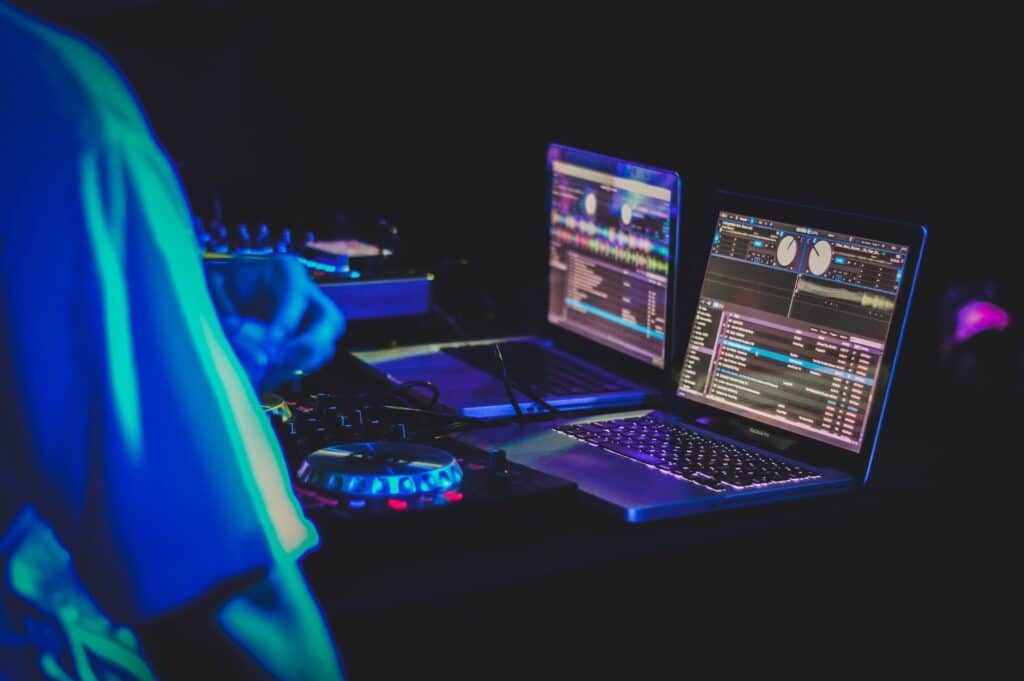
Pioneer DJ rekordbox DJ
Price: from £10 a month (however, some hardware unlocks some software features for free)
Pros:
- Builds familiarity with the Pioneer DJ ecosystem, the industry standard in clubs around the world
- Lots of potential add-ons
Cons:
- Limited range of controller options
Best entry-level controller: Pioneer DJ DDJ-FLX4
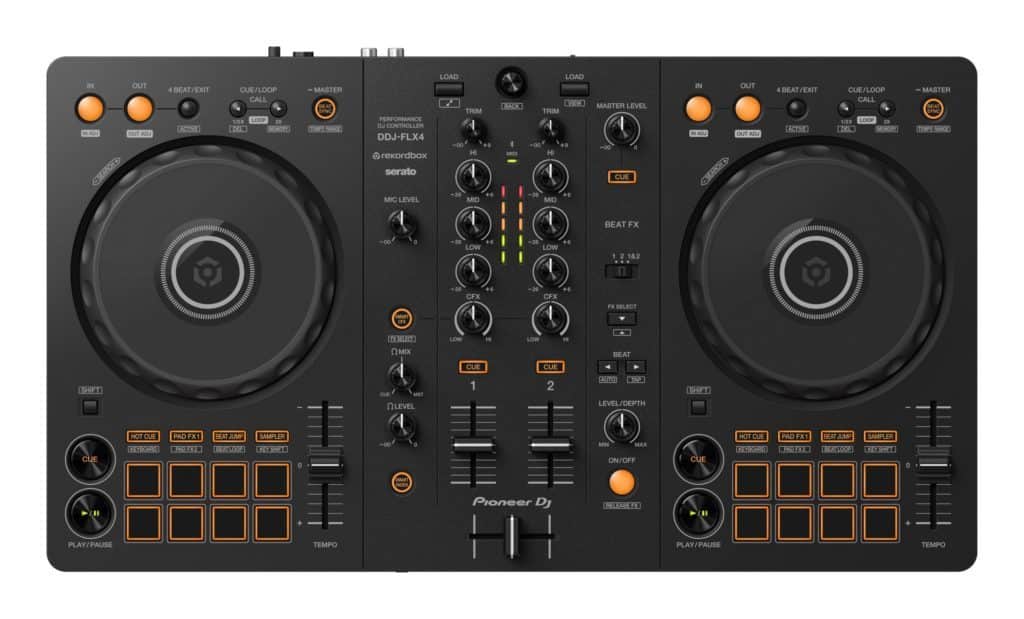
Pioneer DJ are completely dominant in club and festival DJ booths around the world. That makes their rekordbox DJ software a strong contender as your first DJing app.
Anything you prepare, practice and play in the app carries over when you export your music for the club. That means that if you add cue points, loop points, change names, add artwork, tweak labels or even rate tracks while practising at home, it’ll all work when you plug your USB stick into a CDJ or other compatible player.
This is, without doubt, rekordbox DJ’s biggest pull and should be a consideration when you’re choosing your first software.
Even if you don’t intend to use CDJs in a bar, club or event any time soon, you’ll still find compelling reasons to choose rekordbox DJ.
Features
Its mixer is pretty simple and includes all the features you’d expect – three-band EQ (low, mid and high), a dual-band filter per channel, which cuts out low or high frequencies depending on which way you turn it, and a gain knob for each channel, too.
While the layout is a little cramped, the screens display everything you need to know about the current track that’s loaded. Looping is handled via a dedicated button, which can set a loop to a whopping 512 bars!
You can assign the performance pad section to several useful modes:
- Hot Cue jumps to a specific predefined part of a track that you set up in advance
- Pad FX to apply instant FX to a track while a pad is pressed down
- Slicer which splits eight transients into loops
- Beat Jump moves the playhead a set number of bars forward or back
- Key Shift pitch-shifts tracks up or down in semi-tone increments. Plus, there are even more modes to take your creativity to the next level!
The sampler is another nice feature in rekordbox DJ. It gives you eight slots to load in samples like kick drums and snares, vocal hits, FX sounds or even full tracks.
Other features include a mobile app, the ability to design your own lighting and project lyrics as visuals and even a built-in sequencer to trigger external equipment in time with your music.
Effects
FX-wise, there are 34 to choose from, though some are unlocked based on your subscription plan, which we’ll get to later.
You can even chain three FX in a row, and assign the chain to decks one through four, the sampler section or the master output, giving you a total option of nearly 40,000 different combinations!
If that seems excessive, you can switch to one effect per chain, giving you more parameters to control for that effect.
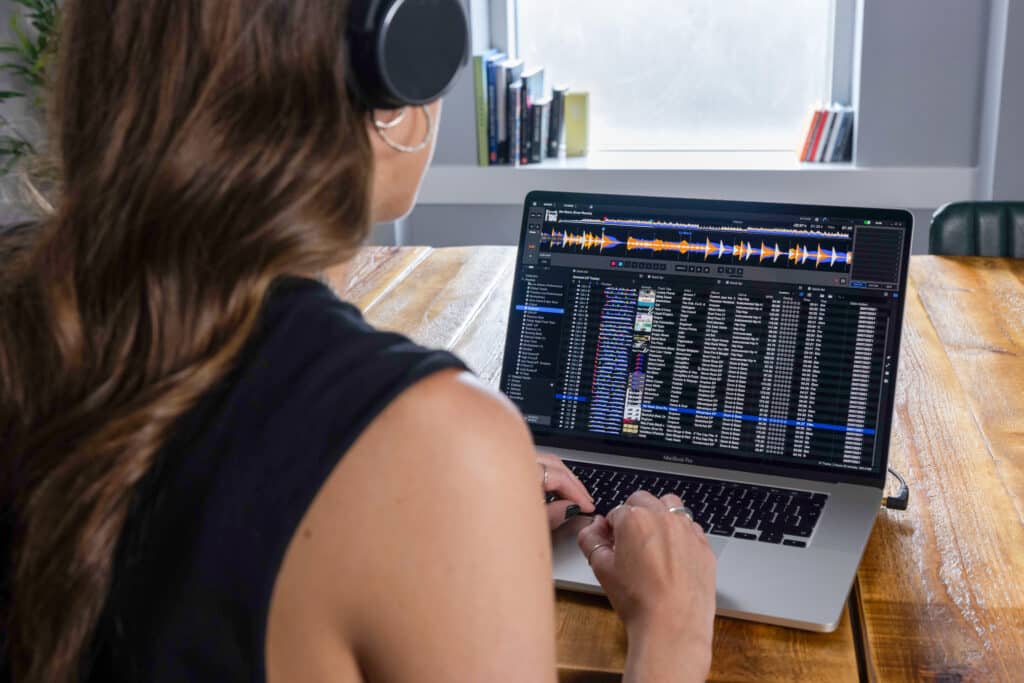
Streaming integration
Another big pull for beginners is rekordbox DJ’s extensive support of streaming platforms. If you’ve not yet managed to build up a large music collection, streaming offers instant access to millions of tracks, streamed straight into your DJ deck.
Beatport Streaming, Soundcloud Go+ TIDAL and Beatsource Streaming are all supported, but all come with their own subscription costs. An important point is that you cannot record your sets when streaming platforms are being used. This applies all DJ software, not just rekordbox DJ.
Downsides
Fitting so many features into a laptop screen means that rekordbox DJ can sometimes feel cramped. There’s a lot going on, and therefore a lot of text, icons and sections that can be confusing at first glance. It’s easy enough to strip things back though, and you can collapse areas of the software you’re not using.
Rekordbox is limited when it comes to compatible controllers as you can only use Pioneer DJ controllers with it. That being said, the DDJ-FLX4, Pioneer DJ’s affordable, portable rekordbox controller, is one of the most popular DJ controllers on the market, even among pros, and is a great option if you do want to stick with the Pioneer DJ kit infrastructure.
If you do want to use your own gear with Rekordbox, there is a way as it does support DVS control, meaning you can use any branded turntables and most mixers in this mode.
Subscription model
As mentioned, Pioneer DJ offer a 30-day trial on their rekordbox DJ software. After 30 days, you’ll need to decide what subscription model is for you, starting at £10 a month or £120 a year for the Core plan.
Like most subscriptions, it’s expensive in the long run but offers an affordable starting point for new DJs who want to experiment with different software before deciding on the DJ app for them.
Please note that all of Pioneer DJ’s controllers will unlock the software for free, however, if you then decide to plug your laptop into a set of CDJs you may need to pay a subscription. There are also other features such as vocal analysis, extra effects and add-ons such as lyric mode, DVS, lighting mode and cloud library sync all bundled into the paid subscription tiers only.
Overview
It’s hard not to recommend rekordbox DJ, largely down to Pioneer’s dominance in the clubs. Learning to DJ on their software and hardware, as well as analysing your music for their kit, and familiarising yourself with rekordbox generally, will put you in a strong position if, and when, you decide to branch out to clubs and festivals.
However, if you’re more interested in mobile DJing at events like weddings, and already own, or are interested in, a non-Pioneer DJ controller there are other options out there that might be better suited.
Learn
If you’re new to rekordbox and want to learn how to DJ with a controller such as the DDJ-FLX4 then check out our dedicated courses below.
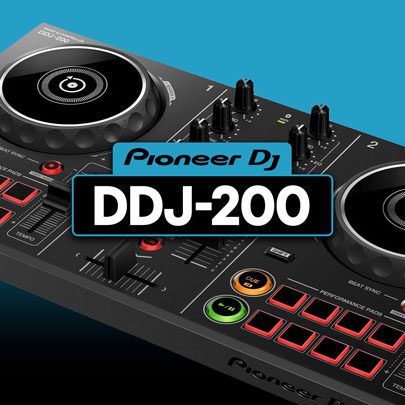
Pioneer DJ-200 DJ Course
4.75 hours
28 lessons
Beginner
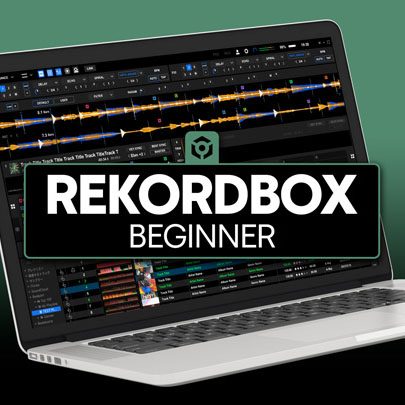
Rekordbox DJ Course
5.5 hours
37 lessons
Beginner
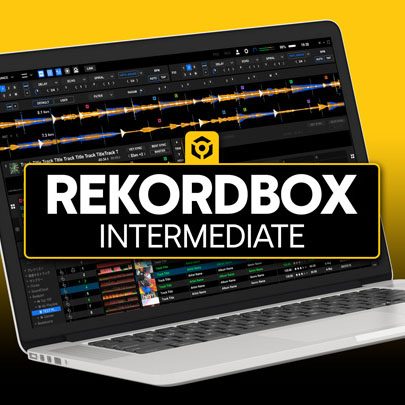
Rekordbox DJ Course
7.5 hours
49 lessons
Intermediate
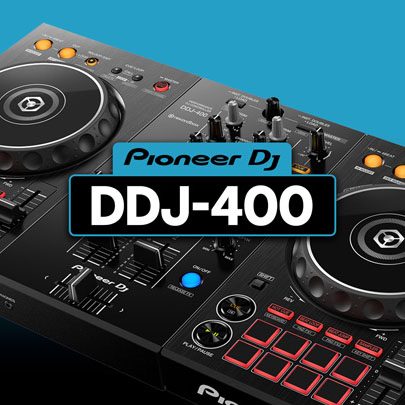
Pioneer DDJ-400 DJ Course
7 hours
30 lessons
Beginner
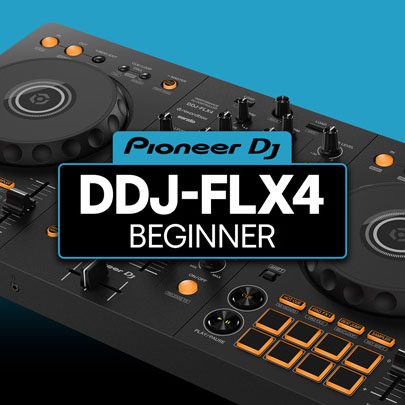
Pioneer DJ DDJ-FLX4 Course
7 hours
41 lessons
Beginner
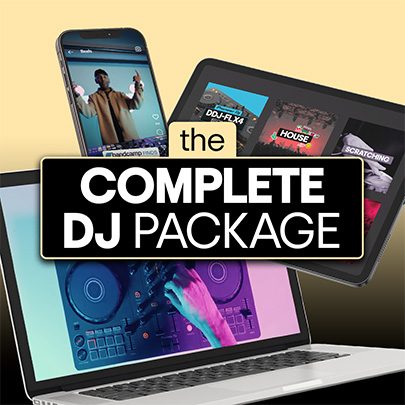
Complete DJ Package
835 hours
1300+ lessons
Creative
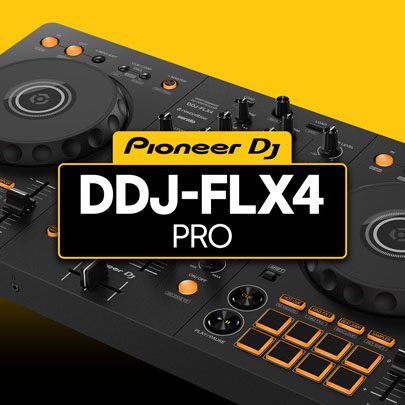
Pioneer DJ DDJ-FLX4 Pro Course
9.5 hours
49 lessons
Intermediate
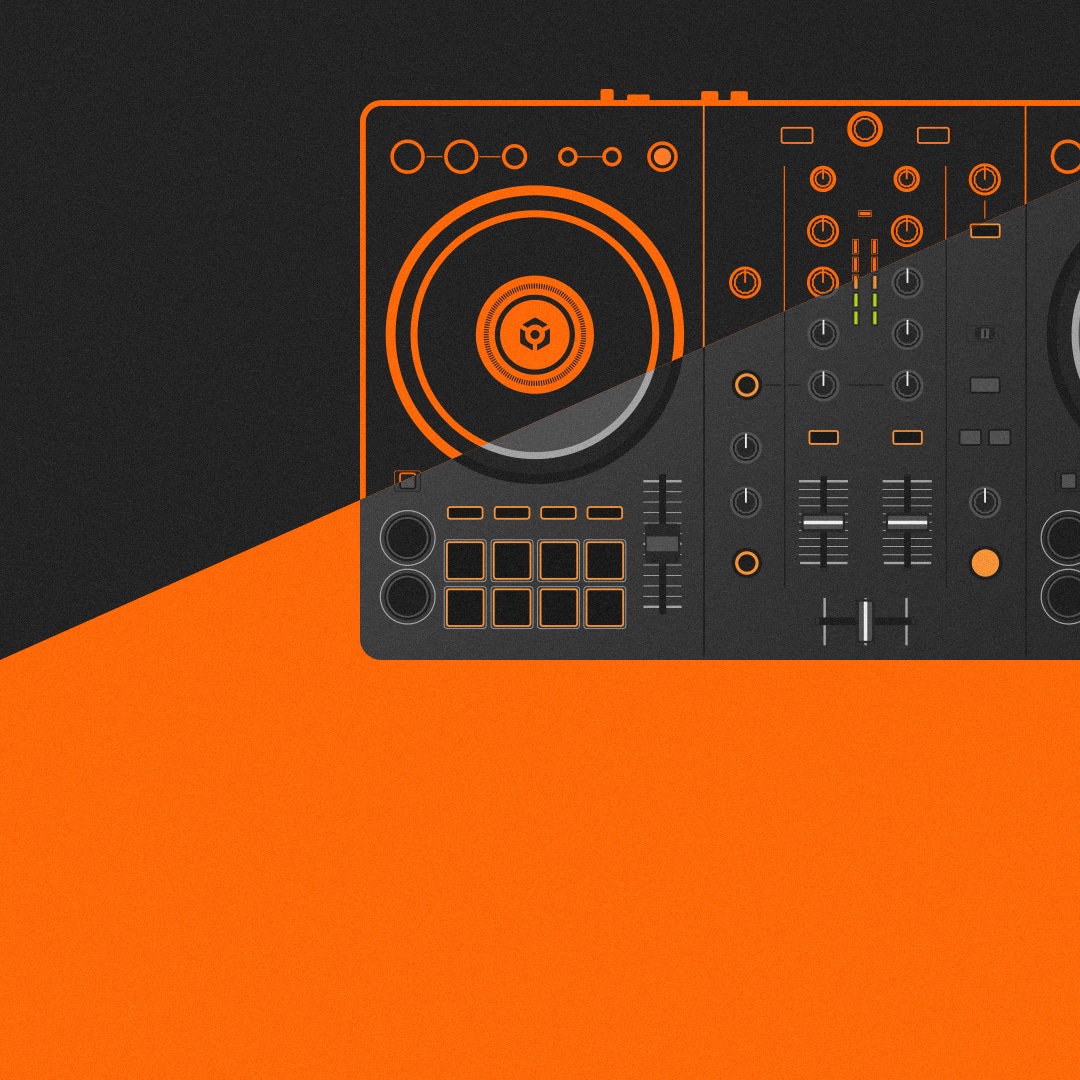
DDJ FLX4 Beginner To Pro Bundle
16.5 hours
90 lessons
Beginner
Serato DJ Lite
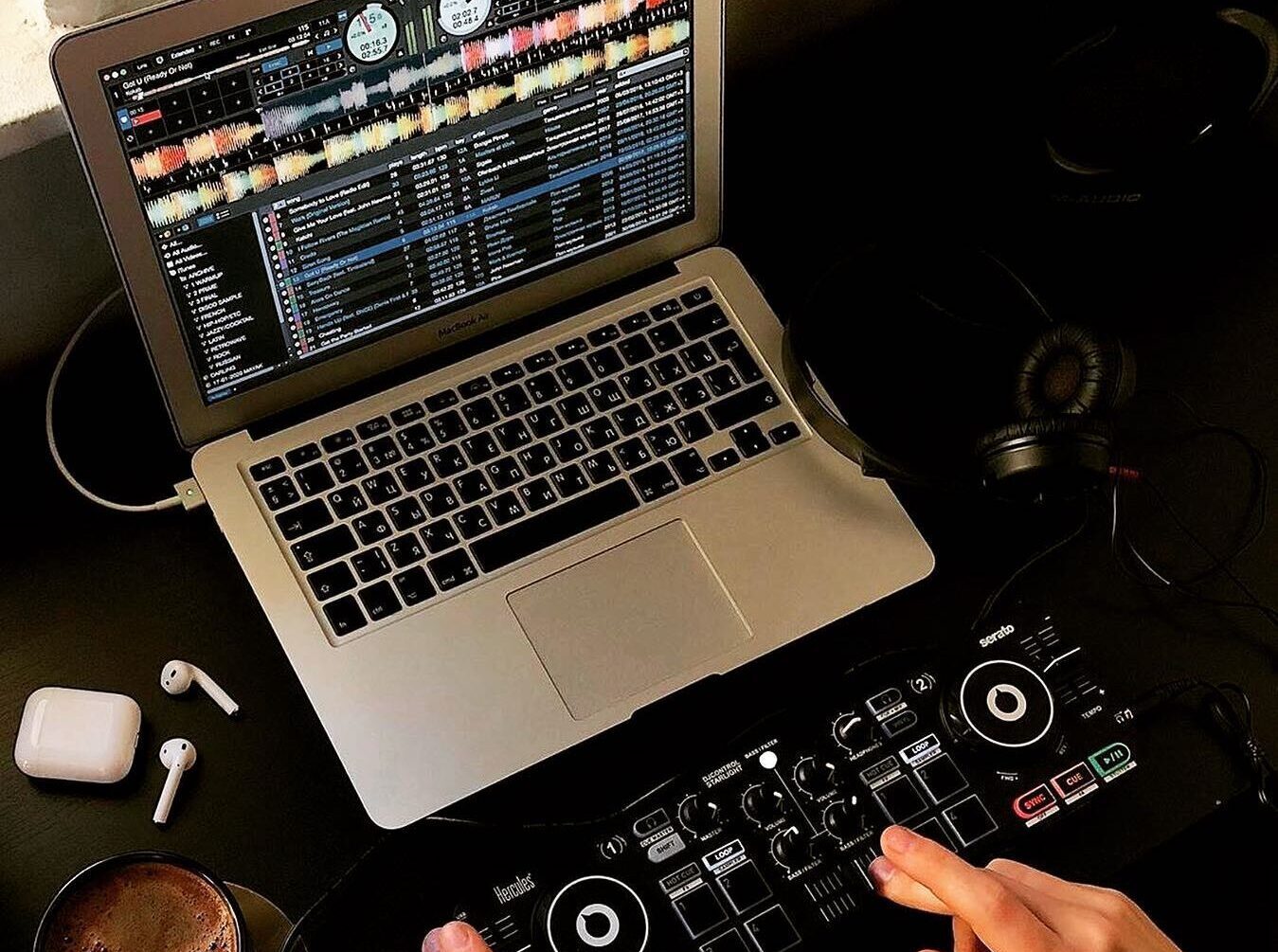
Price: from Free
Pros:
- It’s free!
- Can upgrade at your own pace
- Lots of controllers to choose from
Cons:
- Less FX, no record mode and only one view mode in Lite versus DJ Pro
Best entry-level controller: Numark Mixtrack Platinum FX
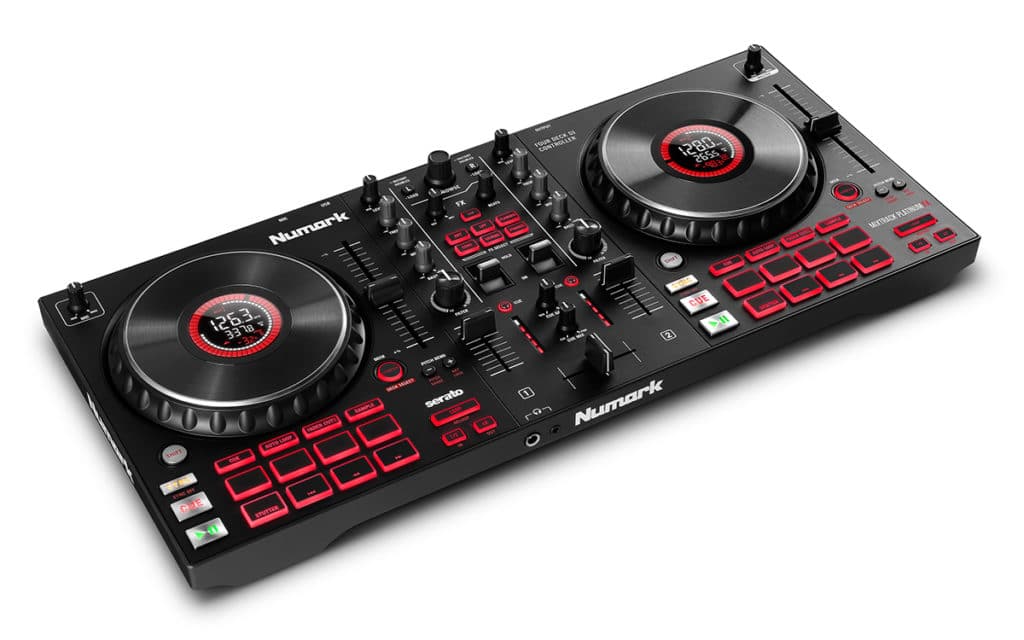
Numark Mixtrack Platinum FX DJ Controller
Serato DJ Lite is a free, stripped-back version of the main DJ Pro software. It might not have the bells and whistles of some other paid-for apps, but it definitely isn’t a novelty and is an excellent choice for learning the basics of DJing.
Features
Serato DJ Lite provides almost all the features you’ll need to get started with DJing. Alongside iTunes support, Serato uses what’s called ‘crates’, which you drag and drop your music files into depending on their genre, style, event, or however you want.
It also offers plenty of streaming platforms alongside your other ‘crates’, meaning you don’t need to build up a huge library of music before starting. Similarly to rekordbox DJ, Beatport Streaming, SoundCloud Go+, Beatsource Streaming and TIDAL are all supported but come with their own subscription costs.
The layout of Lite is basic, featuring two decks with four cue points per deck, as well as looping functionality up to only eight bars. There’s a basic mixer with a volume fader, a trim knob and a crossfader. There’s also a sampler mode to trigger up to four samples to add some hype to your sets if your controller has performance pads.
Controllers
One of the clear benefits of choosing Serato Lite is the range of controllers it supports. Where rekordbox only allows Pioneer DJ controllers, Serato allows you to use a whole range of models and brands including Numark, Hercules, Reloop and Denon DJ as well as Pioneer DJ. This includes the ever-popular beginner controller, the Pioneer DDJ-200.
Pioneer DJ controllers are some of the most expensive on the market. This typically means you can pick up a cheaper controller to suit your needs as a DJ from another manufacturer if you are using Serato. Perhaps one with higher quality jogs for scratching, or one with better performance pads for triggering samples and FX. The full list of Serato-supported controllers is large and can be found on their website.
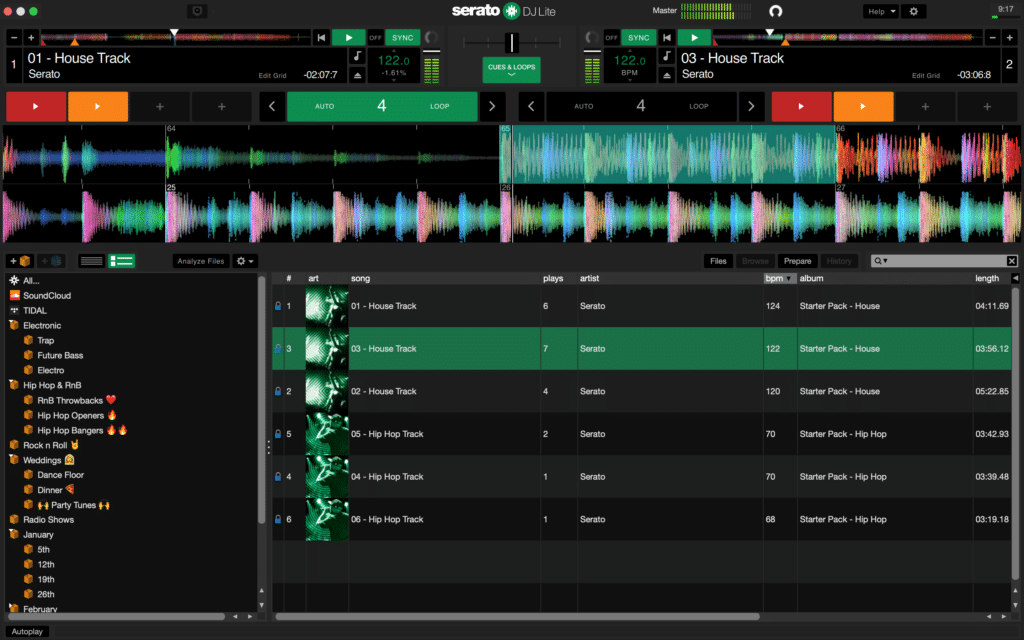
Serato DJ Lite Software
Differences between Lite and Pro
There are some key differences between Lite and Pro that need to be made clear, as they may be important to you. First of all, Lite only has one display mode: horizontal decks. That means you can’t view the waveforms side-by-side, which is the standard setup for a lot of scratch DJs. Lite also won’t analyse the key of a track, though it will analyse the bpm and the waveform.
Lite doesn’t offer as many FX, and they’re less tweakable than in DJ Pro, but there’s still enough to get you started, like reverb, and several phasers and delays.
And finally, record mode is not available in Lite, meaning you can’t record your set directly in the app. Quantise also isn’t available, so you can’t automatically snap your cues, loops and playheads to the nearest bar should you miss the beat slightly when pressing play. This is a major oversight for beginners, who will miss this feature most.
Overview
Serato DJ Lite isn’t basic, but it is simple. If you’re new to DJing and have an older controller or are looking to buy a more affordable one, it’s a fantastic place to start your DJing journey without dropping a lot of money.
There are lots of upgrade options too, so you can scale up as and when you feel your DJing career is taking off. If you’re aiming to be a DJ who switches up their style and tempo often, Serato DJ Lite is a great option to master the art of open-format DJing before moving to Serato DJ Pro.
If you do want to upgrade, you can either subscribe to Pro for $9.99 a month or for $249 upfront, but there are plenty of other tiers available. Find out about Serato’s subscription and payment options here.
Learn
If you decide to try out mixing for free with the Serato DJ Lite software you can get started just using your keyboard and mouse. Follow our 5 part detailed video tutorial guide here to learn how to DJ just using your laptop and Serato DJ Lite. If you already own a DJ controller and would like to learn how to DJ with it using Serato DJ please check out our relevant
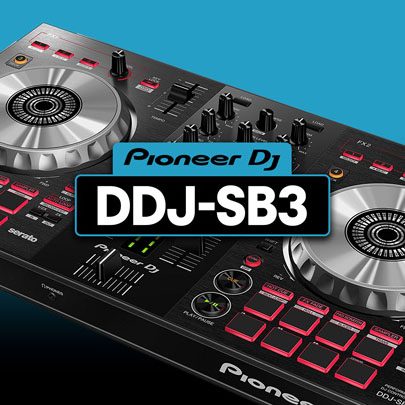
Pioneer DDJ SB3 DJ Course
3.75 hours
28 lessons
Beginner
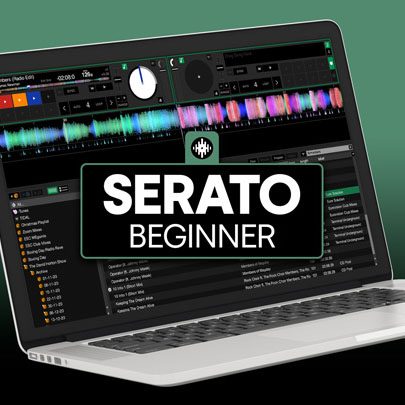
Serato DJ Course
3.5 hours
23 lessons
Beginner
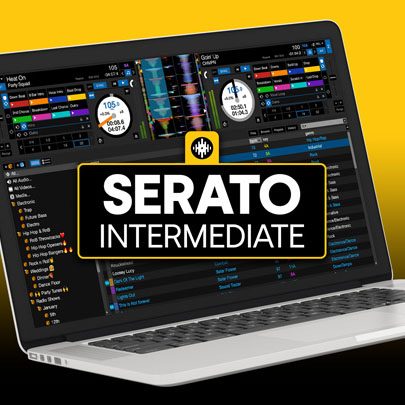
Serato DJ Course
8.5 hours
47 lessons
Intermediate

Pioneer DJ DDJ-FLX4 Course
7 hours
41 lessons
Beginner

Complete DJ Package
835 hours
1300+ lessons
Creative

Pioneer DJ DDJ-FLX4 Pro Course
9.5 hours
49 lessons
Intermediate

DDJ FLX4 Beginner To Pro Bundle
16.5 hours
90 lessons
Beginner
Traktor Pro 3
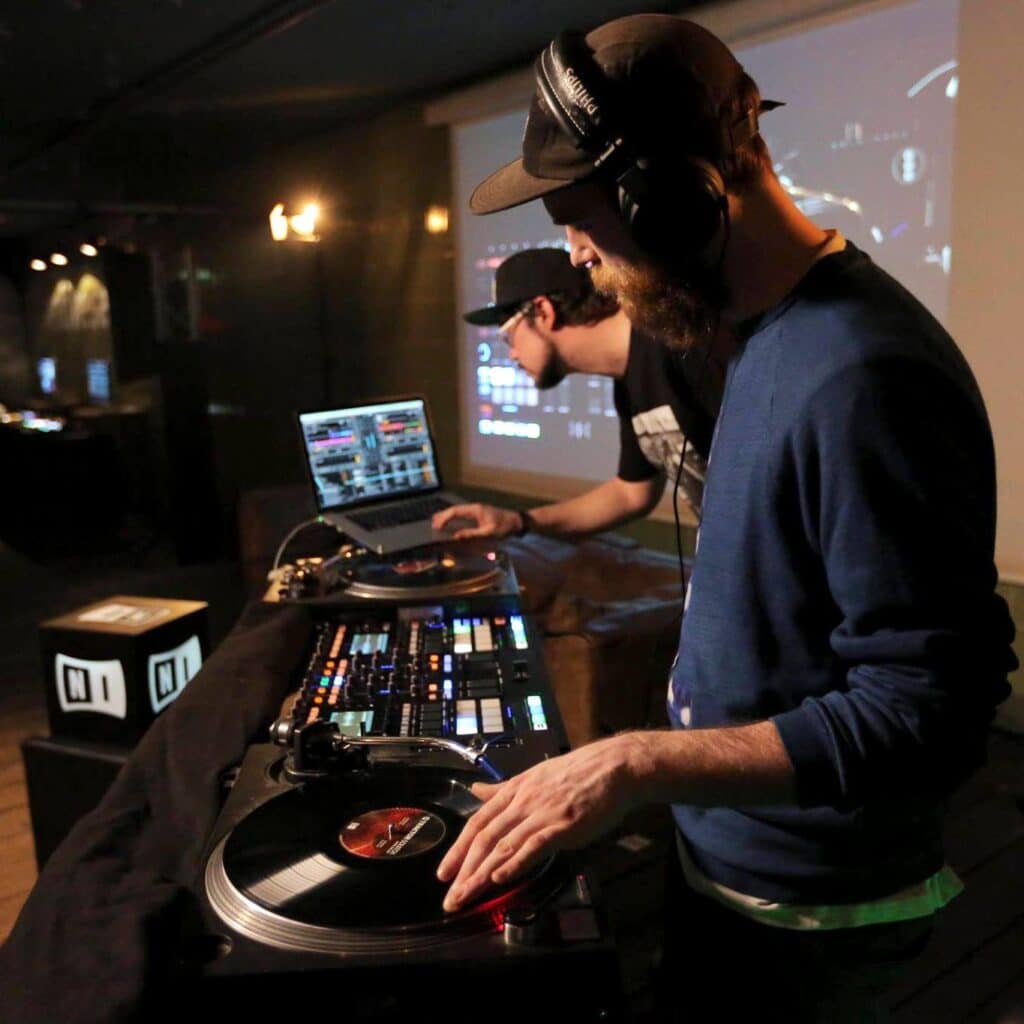
Price: £89
Pros:
- The sound is excellent
- Very flexible for creative DJing
Cons:
- Can be overwhelming for beginners
- Only supports Beatport LINK for streaming
Best entry-level controller: Traktor Kontrol S2 MKIII
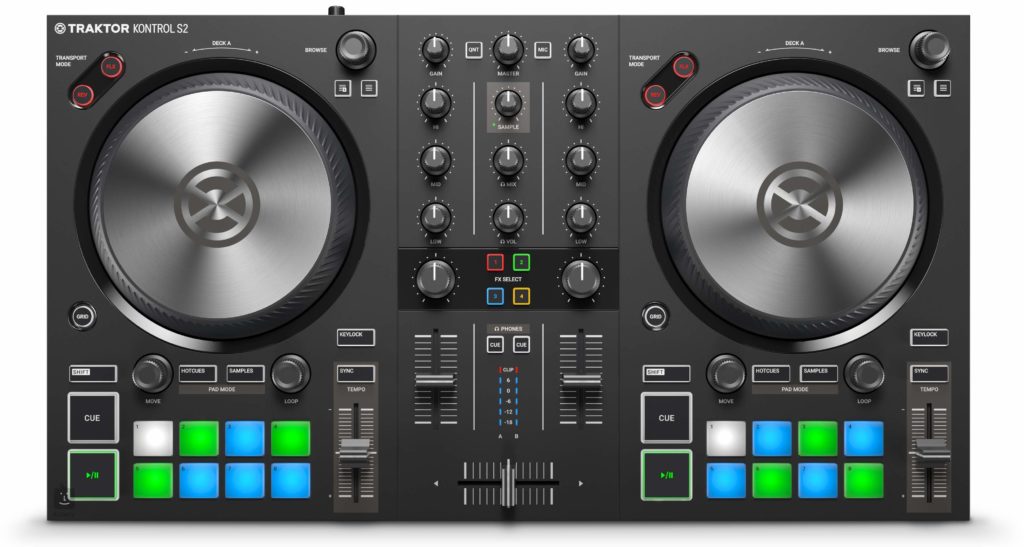
Traktor Kontrol S2 MKIII Controller
Unlike Serato and Pioneer DJ, there are no subscription models with Traktor Pro. It’s £89 and that’s for everything, straight out of the gate.
Though it’s more expensive up front, if you’re in this for the long run it’ll save you money over a year, and beyond. Traktor offers a free version called Traktor DJ 2, which is entry-level software designed to introduce beginners to DJing, with limited functionality. Pro offers a whole lot more so we’d recommend upgrading from the off.
Features
Traktor Pro 3 is extremely powerful, with up to four decks for tracks, as well as Remix Decks, Stem Decks and Sampler Decks, which we’ll get into later.
The mixer features the usual three-band EQ and filter per channel, plus gain and FX assign buttons, to send your deck to one of the four FX decks, as well as a crossfader.
Traktor’s FX are some of the best in any DJ software, not only because of their sound quality, but because of their flexibility. Like rekordbox DJ, you can chain FX or choose to have one per effect deck, if you want more parameter controls of a single effect.
There are the usual delays, reverbs and filters, but there are also presets like PolarWind, EventHorizon and DarkMatter that combine effects and modulations in the background with out-there results. YOu can also chain these and get some very wild sounds – perfect if you want to get creative with your FX section.
Initially, Traktor can be confusing, with so many view options and an extremely comprehensive Settings page. But that also means it’s very customisable, so once you get your head around it you can find your happy place and hide everything you don’t need or use.
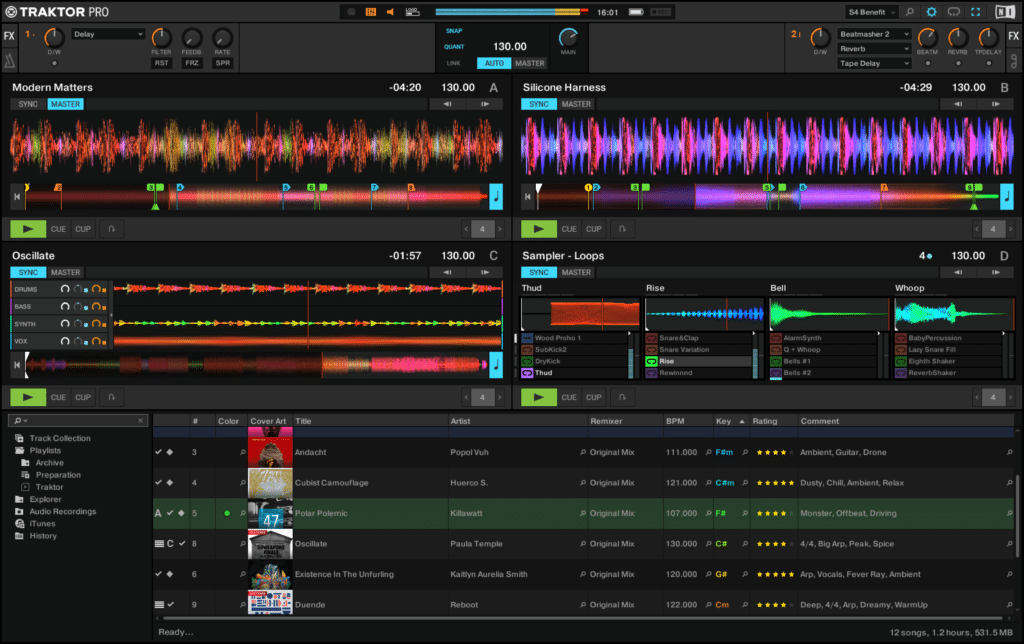
Traktor Pro 3 Software
Traktor decks
Remix Decks are essentially banks and rows of samples that can be triggered, like a miniature Ableton Live inside Traktor. Samples can be one-shots, loops or triggers and can even be full tracks, meaning you can remix and trigger up to 16 sounds within four slots, each with its own filter and volume control.
It may be more than you’d ever need as a beginner, but it gives you a good insight into the power of Traktor and its performance options.
Stem Decks are a similar story, allowing you to load Native Instruments’ own proprietary Stems format into a single deck, which splits the track into four: often drums, bass, pads and vocals, allowing you to live remix, mute and solo various parts of the tracks.
It’s also worth noting that Traktor only supports Beatport Streaming and Beatsource Streaming, with no support for SoundCloud Go+ or TIDAL just yet.
Controllers
The range of controllers for Traktor is fairly limited, with NI making their own official Kontrol range. These are probably your best bet as they work plug and play with no fuss and are laid out exactly like the software.
Traktor does support third party controllers, but unless you already have one, we’d recommend sticking to the official NI-branded offerings. Here’s a list of what controllers Traktor supports.
Overall
If you have aspirations of live remixing, using a lot of FX and are excited by the idea of four-deck mixing, Traktor is definitely a good option. It’s also super-stable, meaning you can tweak and twist without having to worry about crashes.
Learn
If you decide to venture down the Traktor Pro 3 route, we have courses available that will demystify all these unique features such as remix decks, stem decks and complex FX combinations.
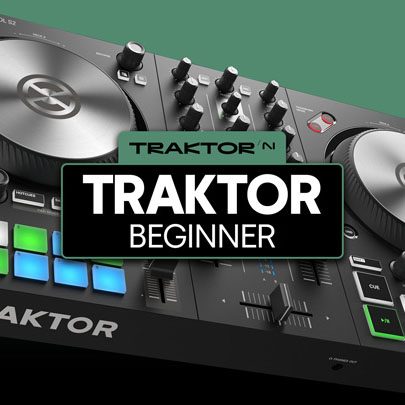
Traktor DJ Course
3.5 hours
23 lessons
Beginner
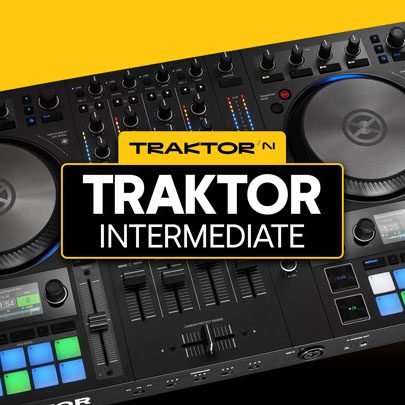
Traktor DJ Course
3 hours
30 lessons
Intermediate

Complete DJ Package
835 hours
1300+ lessons
Creative
Algoriddim djay
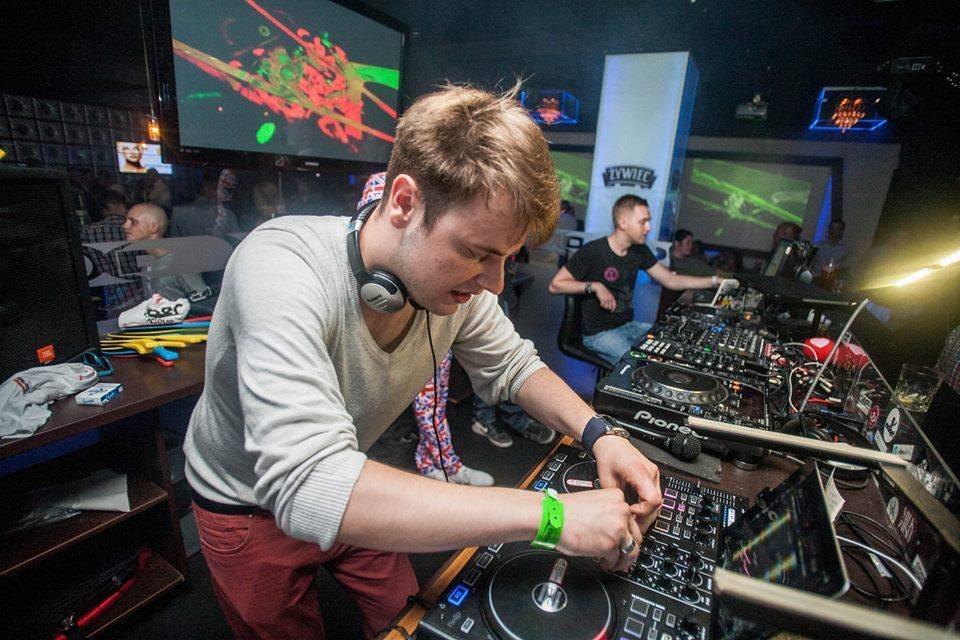
Price: from Free
Pros:
- Intuitive interface for beginners
- Heaps of extras once you start learning
Cons:
- More useful features are part of Pro
- Doesn’t sound quite as good as Serato, Traktor and rekordbox DJ
Best entry-level controller: Reloop BeatPad 2
Algoriddim djay is one of the most popular DJ software in the world. With heaps of awards for its iPhone and iPad app, it’s become a serious contender in recent years, with its desktop app adding some innovative features alongside support for over 50 controllers. It’s also super intuitive with a very friendly interface. Let’s take a look at why Djay is so popular.
Features
Given that Djay was initially aimed at beginner and intermediate DJs, it’s all about usability. It won’t be as daunting as when you first open Traktor or rekordbox as it uses familiar visual cues like vinyl-style decks, friendly faders, and has a colourful interface with large icons and buttons to keep things clear and obvious.
There’s the usual three-band EQ, crossfader and filter per deck and there are heaps of layout options, with a classic stripped-back option, a four-deck horizontal view and a Pro mode which shows almost every parameter upfront for you to tweak. Usefully, all aspects of the interface can be moved around depending on what’s more important to you.
On the surface, Djay may appear a simple DJ software, but under the hood, it’s powered by some impressive AI-driven technology, including the ability to separate vocals, drums, basslines and more from a mixed stereo track. A feature that works much like Stems in Serato, but one that was available beforehand, called Neural Mix.
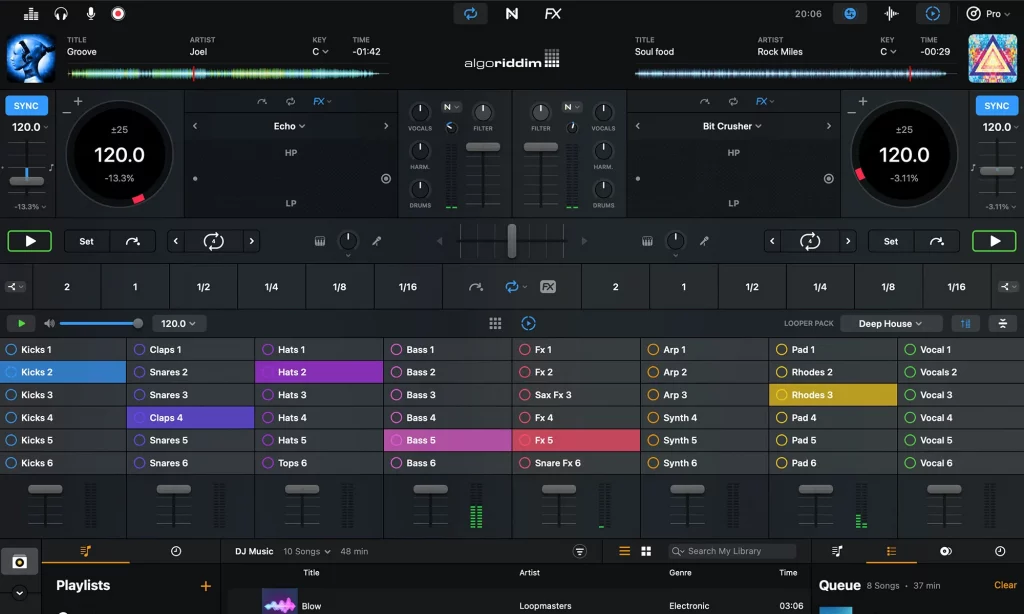
Algoriddim djay Pro DJ App
Other features
Elsewhere, Djay supports video mixing as well as Ableton-style sequencing and looping of loops and one-shots, AI-driven automix and support for TIDAL, Beatport Streaming, and Beatsource Streaming and SoundCloud Go+ streaming.
Controller options include support for more affordable brands like Hercules, to pro-level support for Pioneer DJ’s flagship CDJ-3000s. In fact, it’s got one of the most comprehensive lists of controller support for any beginner DJ software. you can read the full list here.
Another feature we love is the ability to sync metadata between the iOS app of Djay and the desktop version. You can create cue points on your iPhone whilst out and about and they’ll be ready for you when you open the app on your laptop later on!
Overview
All in all, Djay is extremely powerful. It has tonnes of features, some classic, some innovative, and also supports a long list of controllers. It’s also not as intimidating if it’s your first time opening a DJ app.
Its filters and EQs might not sound as good as some of the other more pro-level software like Serato, Traktor and rekordbox, but it’s so flexible, and its Neural Mix is so impressive. If you’re looking to be more of an open-format DJ who plays events and bars rather than just clubs, it’s got to be on your list. It’s also incredibly affordable, with a free and a Pro version at £48.99 a year.
Learn
If all you currently own is a smartphone or iPad then why not check out our Learn How to DJ with an iPad complete guide, here, where we cover all the basics of DJing with just a smartphone or tablet!
VirtualDJ
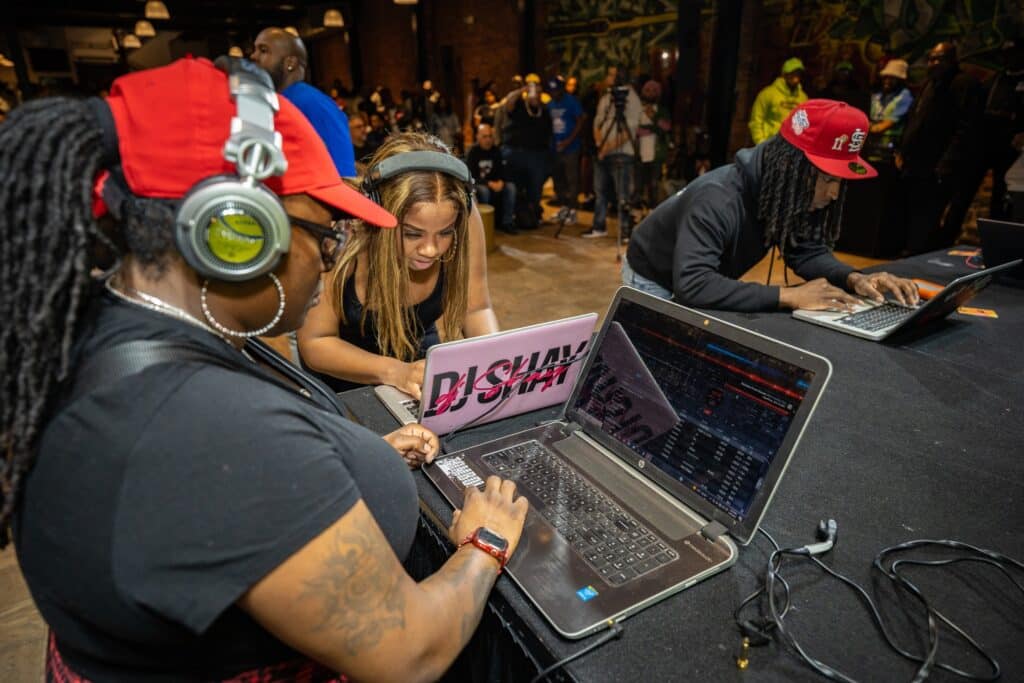
Price: from Free
Pros:
- Most features work in free mode
- Built-in tutorials
- Super customisable
Cons:
- Doesn’t sound quite as good as the other apps
- Can’t use a controller in free mode
Best entry-level controller: Hercules InPulse 500
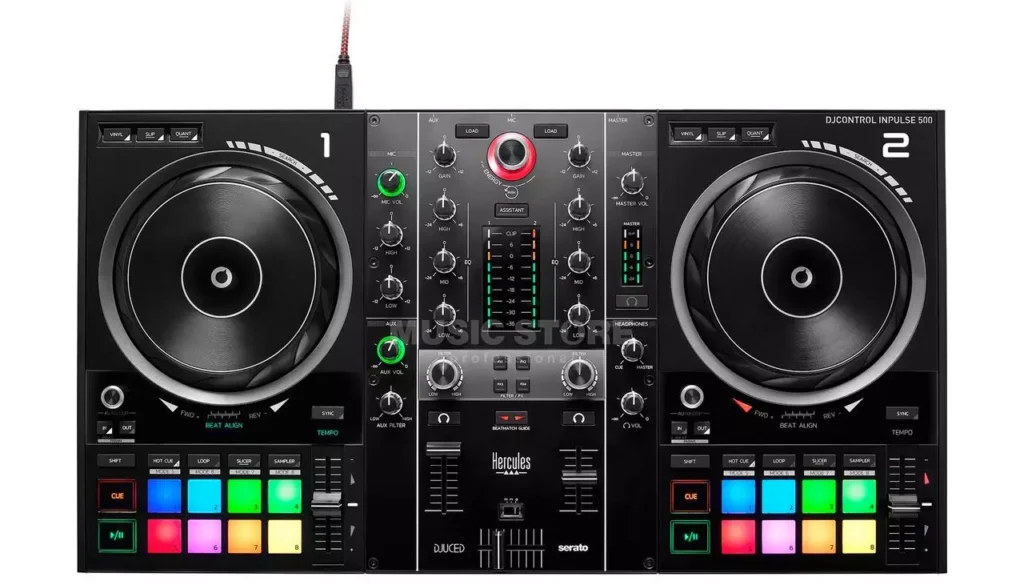
Hercules InPulse 500 DJ Controller
VirtualDJ prides itself on being the number-one most popular DJ software in the world.
Many pro DJs credit it as how they started out. For years, it was one of the few platforms that offered a free version. That meant curious selectors grabbed it and caught the digital DJing bug before moving on to the other platforms.
It’s got over 100 million downloads over the past 20 years, and in recent years it has reinvented itself by strengthening the classics and adding some new pro features, including an awesome new ability to separate musical stems live.
Features
When you open VirtualDJ, you’ll find a beginner-friendly interface, with vinyl decks and large faders and buttons with a simple GUI.
As with Djay, a lot of its power is under the hood.
VirtualDJ has been designed to evolve with the DJ as their skill increases. It begins with a very basic Starter view, then moves on to an Essentials view and then to a comprehensive Professional view, which happily rivals the big three!
In the starter view, you’ll find the usual three-band EQ and filter per deck, alongside some simple FX, a basic sampler and some beat grid patterns for chopped-up repeats.
If all you want to do is mix two tracks together with some FX and a filter, VirtualDJ will do it perfectly.
There’s also a handy Match button to sync things together so you don’t need to worry about drifting out of time early on in your DJ journey.
Another super useful feature is Key Match which automatically syncs the key of your tracks to avoid clashes.
Once you’re ready to move on from the Starter layout to Essentials, more buttons and options appear, including Hot Cues, further loop controls and an expanded mixer view.
You can move at your own pace, and when you’ve mastered Essentials, the Pro mode adds even more control to the mix, including a Serato-style jog wheel, yet more Hot Cue and effects controls and some awesome user-assignable buttons that can trigger whatever suits your DJing style.
How deep you go is up to you, which makes it a great program for beginners.
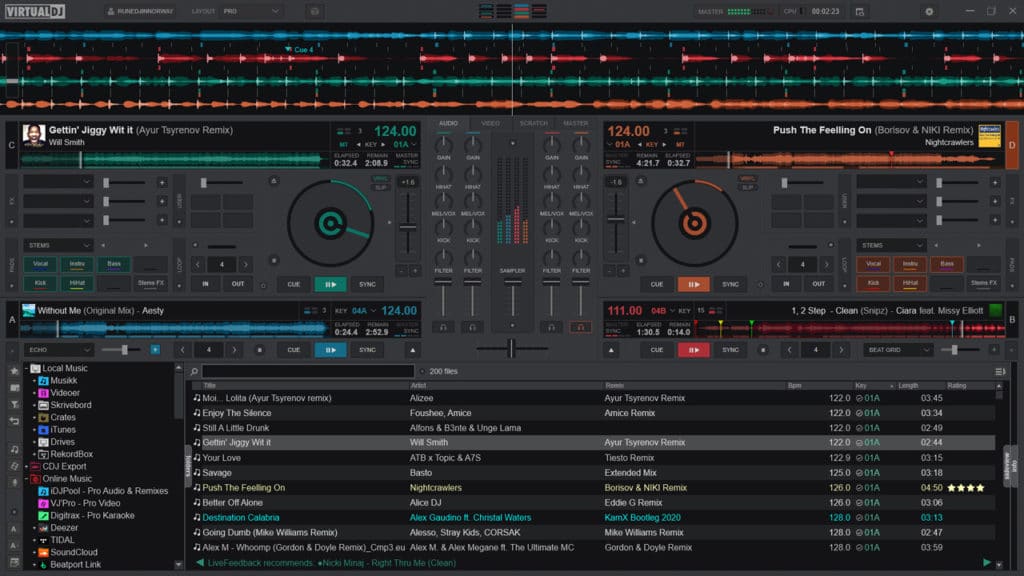
Virtual DJ Software
Controllers
While Djay has one of the largest lists of supported controllers, we will go out on a limb and say VDJ supports the most, with a huge list of compatible hardware on its website.
But, the free version of VirtualDJ doesn’t support MIDI controllers, so if you want to go beyond mixing with the mouse, you’ll need to upgrade to VDJ Home for a one-off fee of £50 to use domestically with a single controller or subscribe to the Pro version for £20 a month.
You can also buy a Pro licence outright for £300. Some controllers do come with a VDJ Home license so you can use it to practice.
The Pro version also adds DVS control and can broadcast directly to a radio server.
Overview
VirtualDJ is extremely customisable, with skins built into the app that can totally transform how it looks, often mimicking existing hardware.
It also has tutorial videos as part of the software to get you started with the basics of both DJing and VDJ.
Its stem separation is a lot of fun but is not without its imperfections. It also supports streaming platforms TIDAL, Beatport and Beatsource Streaming and SoundCloud Go+, as well as a huge range of controllers.
The Pro license isn’t cheap, but if you don’t intend on playing out any time soon and just want to practice, grab the free version from their site and start exploring.
Learn
VirtualDJ is a great starting place for DJs wanting to nail the basics and beyond.
We’ve put together our own free short course for beginners wanting to get a full snapshot of what it takes to become a successful DJ. On it, you’ll go from launching a DJ application for the very first time to feeling confident behind your decks and making preparations for your first paid gig.
Learn to DJ your way!
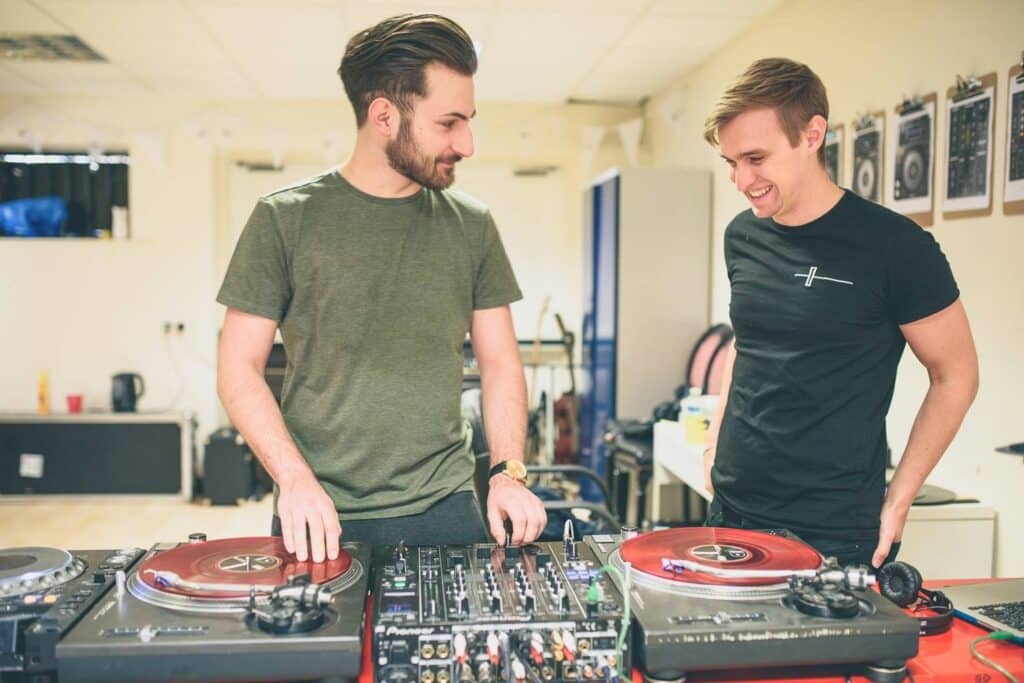
The good news for beginner DJs is that there are lots of powerful DJ software options available at very affordable prices, some of which are even free!
A subscription model lets you access the same software and features that pro DJs use without spending hundreds of pounds.
The software and hardware combo that’s right for you really depends on what you are looking for from a DJ app. Perhaps you want to perform club and festival-focused sets using industry-standard equipment. Or maybe you simply want to jam at house parties with friends, learn to scratch, and do some open-format stuff. Or, it could be that you want to start playing bar and wedding gigs, or a combination of all of these.
We wrote this guide to give you an overview of the most popular DJ apps and what their main strengths are to help you figure which best suits you.
Be sure to check out the free short course mentioned above to give your DJ career a kick start. And if you’re feeling pumped and want to take things all the way, we’ve got you!
The complete package for beginner DJs
We designed the Complete DJ Package for beginner DJs to be the ultimate resource, regardless of skill level. For a one-off affordable fee, you’ll get lifetime access to all the tools and resources you need to be successful.
That includes,
- Our entire DJ course catalogue, including all future updates and aditions!
- Professional feedback on your sets
- Ongoing technical support and advice
- Exclusive content and crash courses
- Invitation to our private Facebook group and Discord Servers
We’re so confident in the value of this package that we offer a 60-day money-back guarantee!
But if you’re still finding your feet and want to try your hand at DJing at a slower pace, check out our courses for beginners to get the most out of your chosen software.

Pioneer DJ DDJ-FLX4 Course
7 hours
41 lessons
Beginner

Pioneer DJ DDJ-FLX4 Pro Course
9.5 hours
49 lessons
Intermediate

DDJ FLX4 Beginner To Pro Bundle
16.5 hours
90 lessons
Beginner

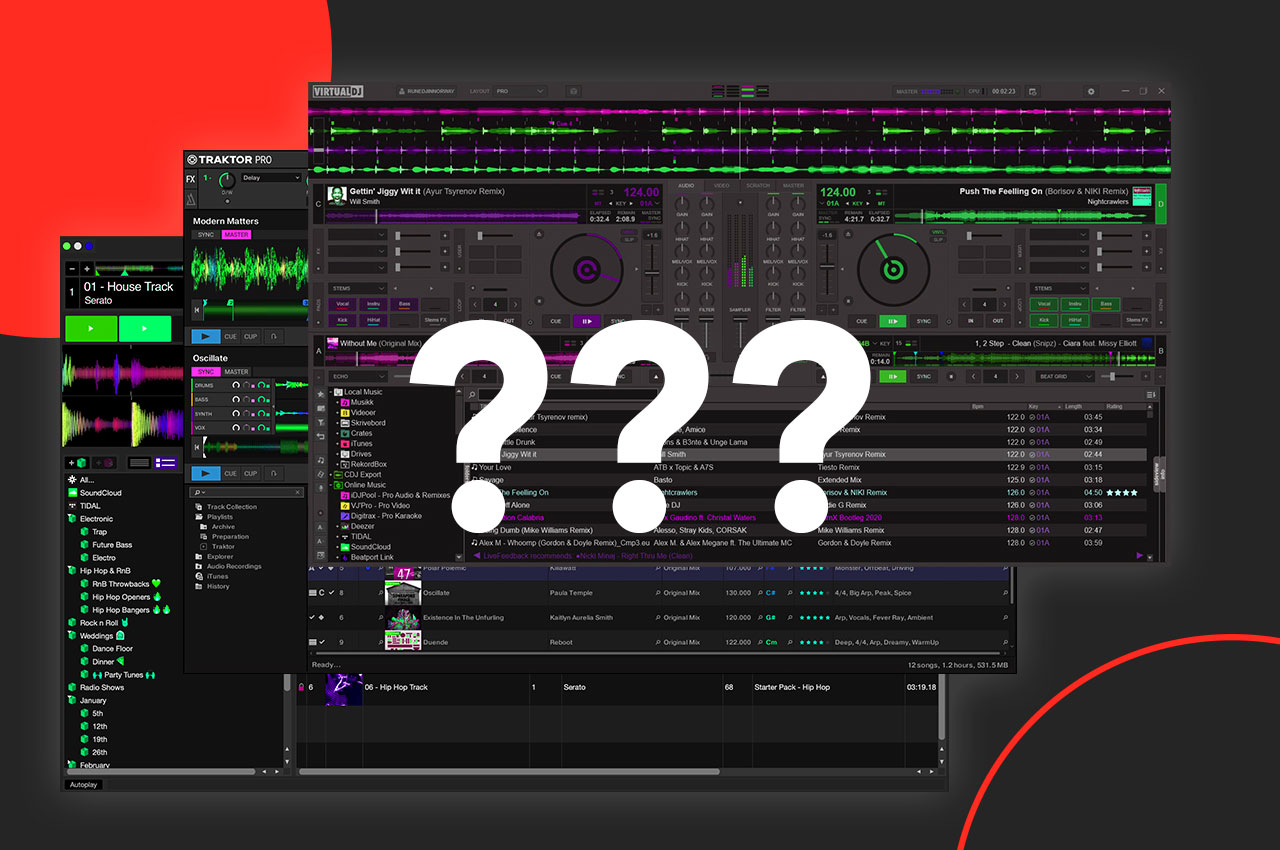
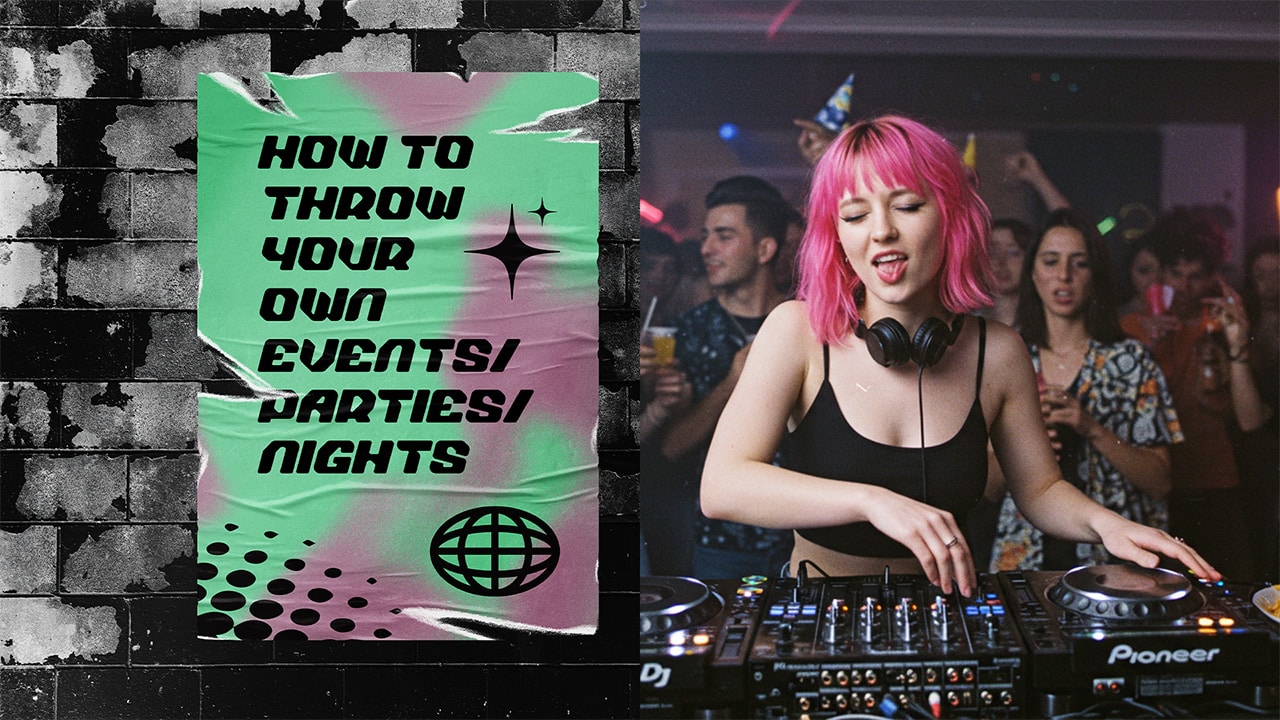
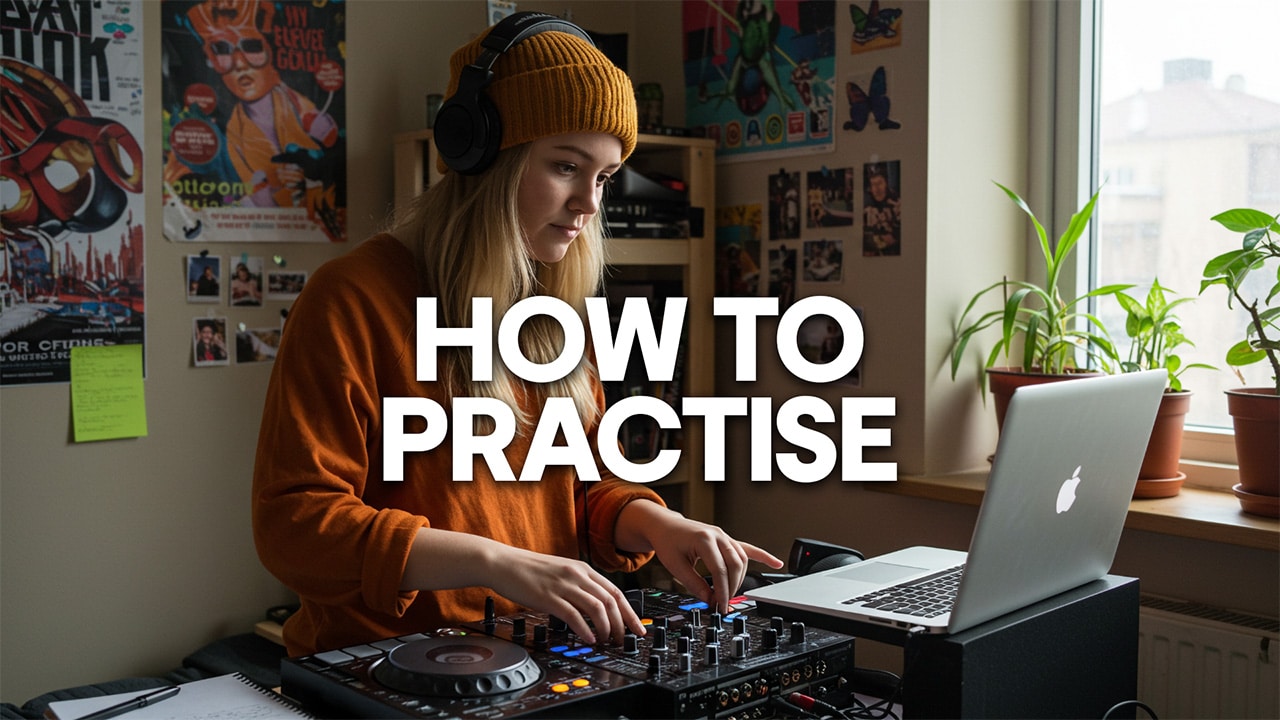
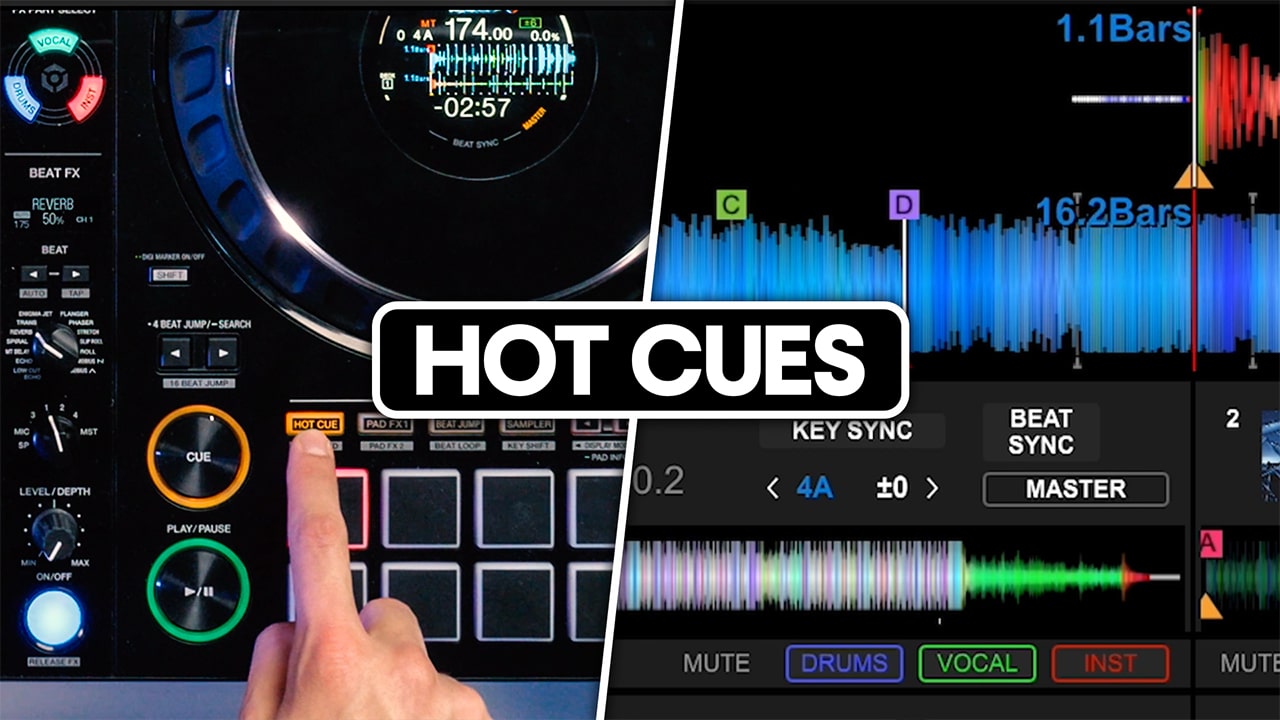
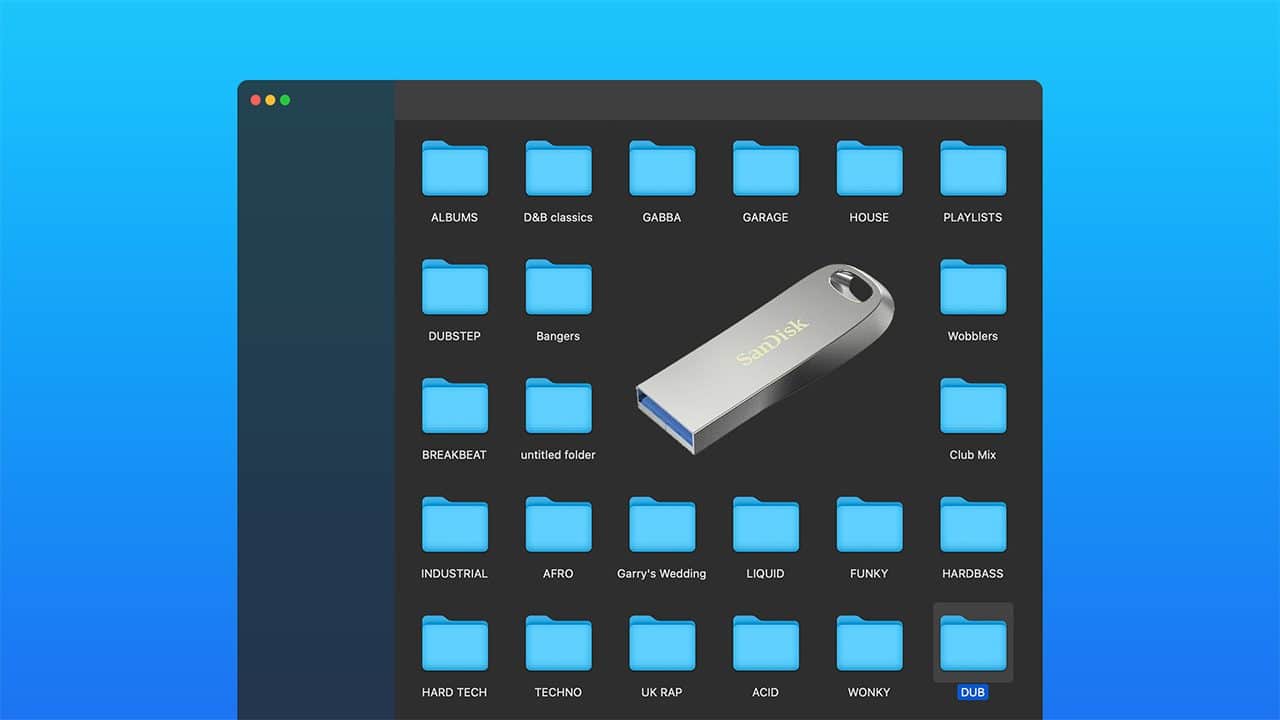
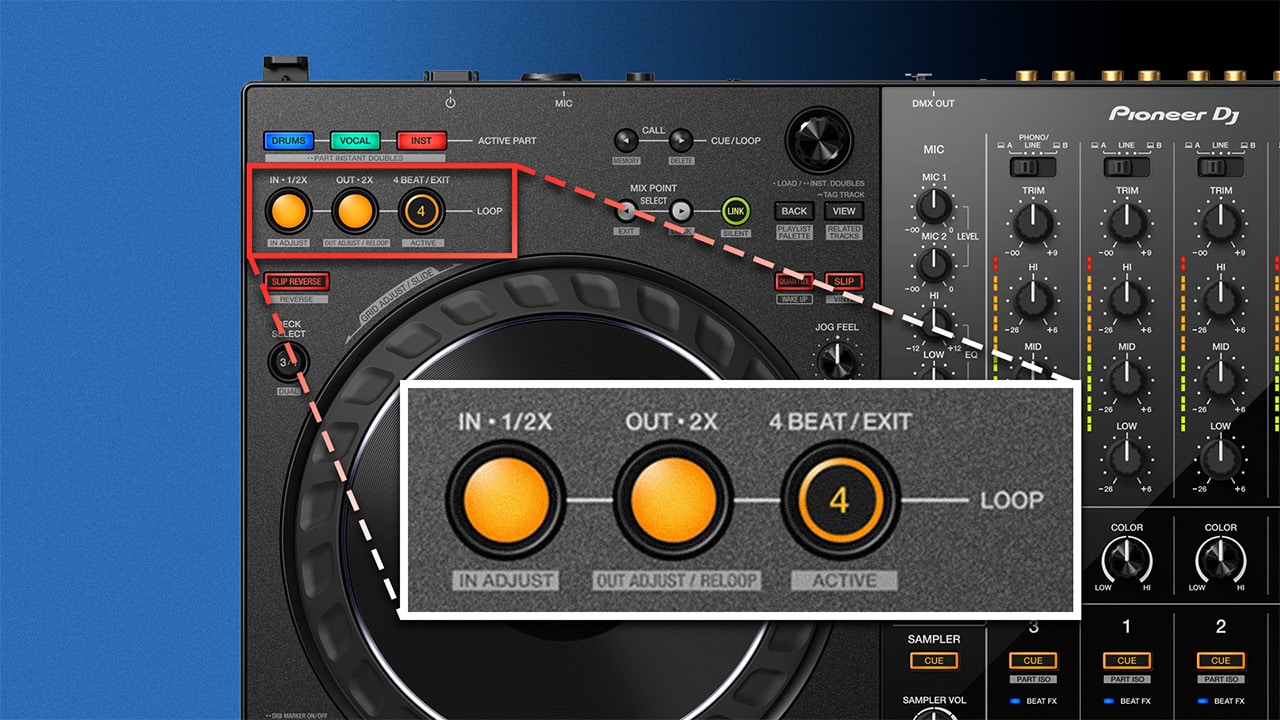
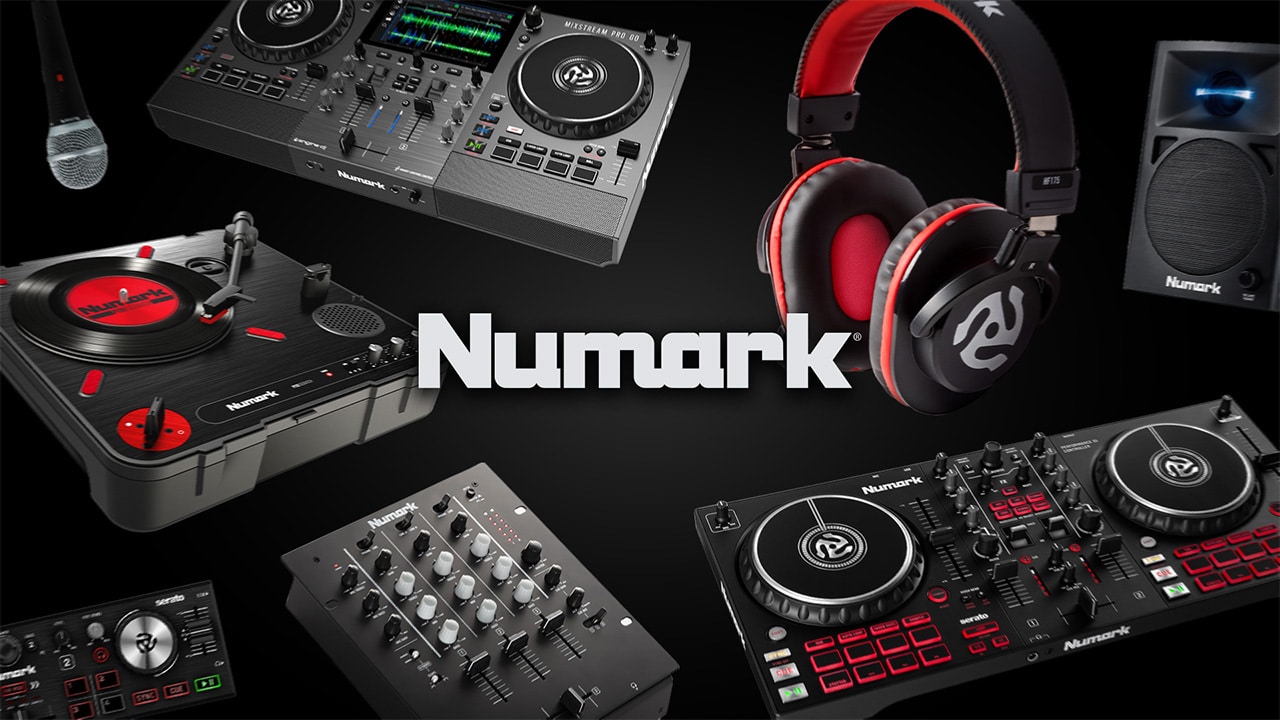
0 Comments
Trackbacks/Pingbacks